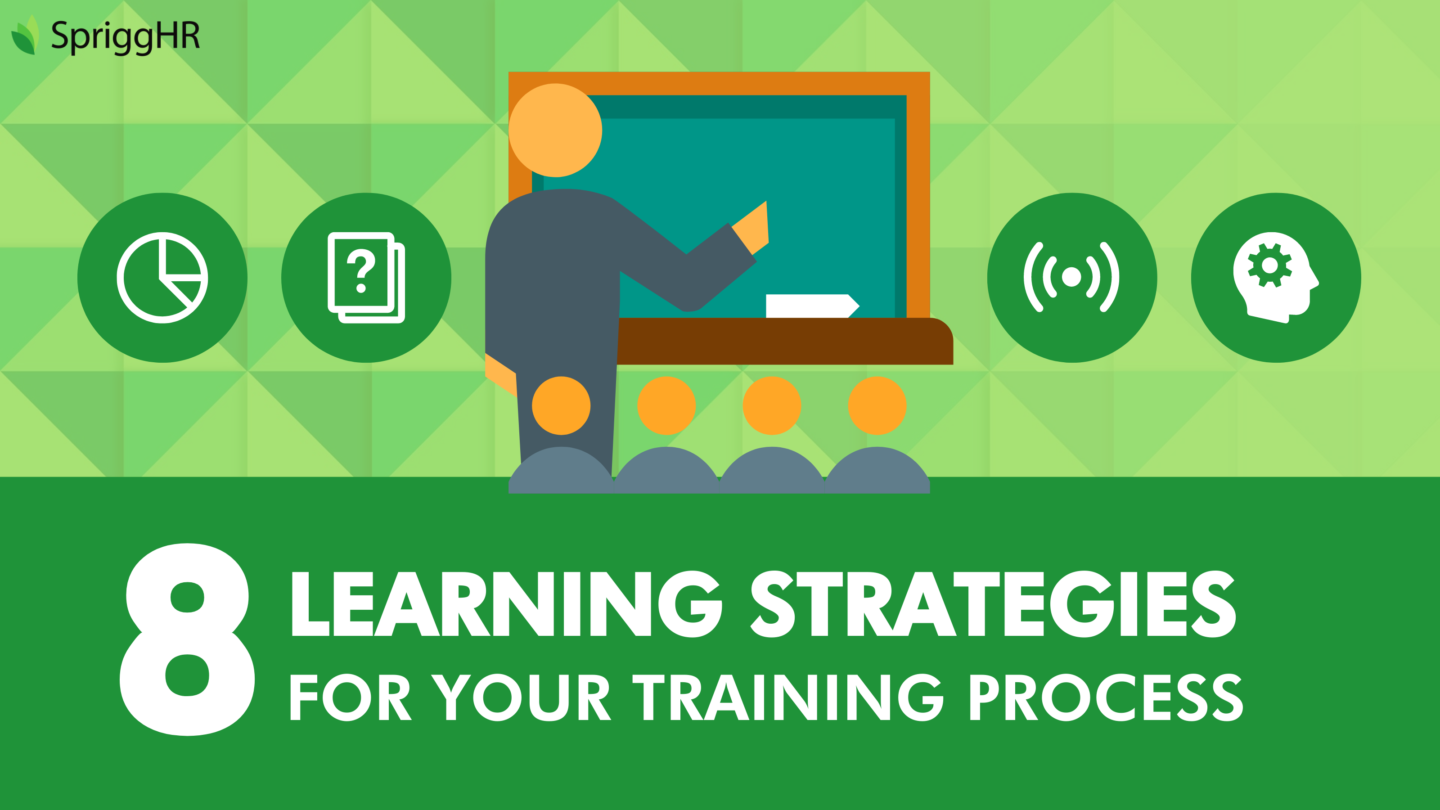
8 Learning Strategies to Optimize Your Training Process
Not everyone will learn at the same rate or in the same fashion. Training processes for new recruits need to be conducive to all types of employees, taking into consideration the diversity of learning styles. This can only be done when you learn how to effectively optimize the training process itself to suit as many learning strategies and methods as possible.
The Individuality of the Employee
Learning strategies, at their core, simply refer to the methods that students use to learn. In a job training environment, this means the ways in which new recruits learn, absorb, and apply the skills and practices being taught to them by their employer.
Learning strategies cover a broad range of applicable uses, from techniques used to retain information long term, or better ways to absorb the information being taught to them efficiently. However, it is important to keep in mind the facilitator’s role in optimizing the learning process. The way in which the materials are presented are just as critical to their successful education as how the new recruits learn them.
The Importance of Learning Strategies in the Development of Training Programs
Incorporating the individuality of the employee, and the wide range of learning strategies that come with them, into your learning and development is critical to optimizing your company’s training process. The importance of incorporating a varied set of learning strategies into your plans for training processes can be boiled down to three main reasons, as determined by what employees and new recruits themselves seek out in employers:
Flexibility
Employers who offer flexibility to their employees are widely sought-after. Flexibility in all areas of work, including communication, scheduling, and salaries, are all viable at one point or another, depending on the employee’s needs.
However, flexibility pertains to more than simply where and when an employee works – it also extends to how employees want to do their jobs, including training. Incorporating various learning strategies into your training process provides more employees with the necessary tools to do their tasks effectively, and on a much more individualized level.
Well-Being
strengthening employee skill sets is one of the principal goals of training itself. Paired with the increased focus on the health and well-being of employees, and the increased demand for employers to provide expectations well-suited to accommodate employees’ personal and work lives, methods of well-being in the workplace lend themselves to adaptive training processes.
Added learning and development, that is adaptable and conducive to several learning styles, leads to further employee company advancement. And, in turn, this translates to financial well-being and satisfaction for employees.
Purpose
Any individual, regardless of company ranking or learning style, responds much better to organizational and task-based demands when they have a clear sense of purpose in what they are doing. Simply put, every individual in a company wants to feel like their job is counting towards the greater good of the organization.
Because of this, incorporating topics that aim to build a sense of purpose, such as workplace communication, company objectives, and understanding what the company offers, is critical. By drawing on learning strategies, you can cover this critical area of morale improvement, and can translate what the overarching purpose of every individual employee’s contribution actually is.
The Top 8 Learning Strategies to Optimize Your Training Process
Incorporating various learning strategies into your organization’s training program has a tremendous impact on how, and what, your employees retain from their time in training. For smaller companies, it can also mean the development of customized learning programs that fit every recruit’s unique learning style.
But, in order to incorporate learning strategies, you first need to be aware of the leading strategies that employees today tend to rely on during training processes. Aim to incorporate these into your training programs and gain the top talent necessary for organizational success.
1. Bite-Sized Learning
Attention spans and concentration patterns vary depending on the individual, but it has been proven that nearly everyone retains information more over time if they break their learning up into smaller, bite-sized portions.
Rather than offering a single, extensive training session that covers all aspects, break sessions down into modules. Identify the key topics and spread over a course of time. This way, employees can fully absorb one concept before shifting focus to the next. This also provides the opportunity for employees to recap what they’ve learned so far, ask questions and clarify any confusion, and then apply that new knowledge to the next lesson.
Bite-sized learning sessions can be broken down in several ways, depending on the size of the training program and the number of participants or necessary areas to cover. Some common ways to break information up includes separating the following topics into distinct training sessions, with attendees varying depending on the necessity of their attendance:
- Sales Training
- Compliance Training
- Safety Training
- Software Training
- New Hire Training
- Product or Service Training
2. Retrieval Practice
Learning information, and retaining information, are two entirely different outcomes. Since employees are almost always engaging in multitasking in their jobs, it isn’t uncommon for newly learned information to be forgotten. This is what makes retrieval practice such an integral learning strategy.
Unlike in school, where you would attend lectures, take notes, study from those notes and then be quizzed on what was learned, retrieval practices forces employees to use their memory, not relying on the crutch of notes or enforcing a study-testing system. Some ways to do this include having employees write out what was learned to see if they can recall the material or holding group discussions on what was learned. The ultimate goal should be to evaluate whether everyone attending the training session can recall the material learned, without looking through notes or handouts. This will provide a gauge on whether employees have truly absorbed the information being taught to them.
3. Elaboration
Another useful retention strategy, elaboration forces employees to dig deeper beyond simply recalling what has been learned, and actually explain in great detail what the specific concepts are. The objective of elaboration is for employees to connect what they have learned to actual, real-life experiences. This demonstrates how the new material should be incorporated into the individual’s decision-making process as a whole.
There are several ways to incorporate elaboration into your training processes, but one of the most widely used is the method of interrogation elaboration. This is when you have employees ask themselves how and why a new concept works, and then have them come up with the answers to those questions. They should make lists of everything to be learned, and then formulate questions around each topic, aiming to answer some of these questions with the objective of identifying connections between various sub-topics of a lesson.
4. Interleaving
Almost all of the best learning strategies aim to focus on the retention of all new information being taught. Interleaving is another great retention learning strategy to incorporate into your organization’s training process. Essentially, interleaving is memorizing new material but woven in with other known skills. So, rather than focusing on one single concept at a time, there are several concepts within the same lesson plan. Doing so forces the learner to pay attention to relationships between concepts and models giving a richer experience to what is being taught.
5. Examples
Real-life, concrete examples are a solid learning methodology, and with good reason. Oftentimes, when new concepts or skills are introduced, it can be hard for a learner to see how they apply or relate to their actual life, or work efforts. By drawing on the method of concrete examples in abstract lessons, those concepts become usable ideas for employees.
Concrete examples are examples that are easily relatable and look to gel understanding. Simply put, they readily resonate with the learner. Because of their relevance, it is easy for them to translate into actual experiences, which helps clarify the importance of concepts to learners. Concrete examples can also be measured and observed, which can help learners deepen their understanding of the concept itself.
6. Dual Coding
In today’s world, there are so many distractions that keep people from focusing on what’s important. In training environments, it can be difficult for people with certain learning styles to properly absorb what is being taught to them. As someone who may be responsible for knowledge transfer, it is your responsibility to be able to minimize these distractions. This can be done by employing dual learning, or dual coding, a method that aims to use different mediums to teach concepts in order to reach as many people as possible.
Advertisers use social media, videos, memes, and graphics, to catch your eye. Your training program should aim to do the same thing. Dual coding is largely linked to visual learning, drawing on visuals to teach concepts rather than lectures or notes. The principle goal is to be able to explain a concept in both words and visuals, meaning any information taught is accompanied by some sort of visual component to aid visual learners. This can be infographics, comic strips, diagrams, graphic organizers, timelines, or graphs. Since everyone learns differently, it is important for training facilitators to make their content as accessible to everyone, on all fronts, in order to receive unanimous understanding.
7. Metacognition
Metacognition, as the name suggests, is simply the process of thinking about thinking. In a training or work environment, it refers to how an individual thinks about life and work. it involves a self-reflection on future goals, actions needed to be taken to achieve those goals, and strategies to use to reach personal targets. Unlike other learning strategies that have a distinct process you need to work to implement, every human being is typically well-equipped with metacognition.
However, although we already possess it, metacognition can be developed in such a way that it becomes a useful learning strategy. When practiced enough, it can help propel an employee to improve their knowledge and skills base far beyond what are taught to them in training sessions.
8. Lateral Learning
With standard logic, you begin with certain pre-existing ingredients, just as you start a game of chess with given pieces on the board. But, what are those pieces exactly? In most work scenarios, those pieces are not explicitly given, we just assume they are there. We assume certain concepts, boundaries, and perceptions, before beginning our work. Lateral thinking, as defined by Edward de Bono, is not concerned with playing with existing pieces, but rather, with seeking to change those very pieces. In other words, it is concerned with the perception part of thinking.
In order to understand the method of lateral learning in the frame of corporate learning strategies, consider it in context of a workplace example. Say you develop a training course in sales techniques, with the end goal of getting employees to use the new strategies to gain new customers. However, although you are providing the new skills to the employees, the issue is the assumption that the ideal situation is bound to play out when using them. But in real life, perfect examples never play out exactly as they were taught. Lateral learning fixes this issue. It teaches employees to take what is taught, and then use their own perception and instinct to know when to use each particular skill.
Training is Only the First Step to Creating Positive Change
It’s one thing to create a training program for your company, but it is entirely different for employees to engage in the learning process itself. By utilizing different learning techniques, varying training methods, and giving employees new ways to master skills, it can help learners to overcome the obstacles in their learning process, leading to better performance overall.






